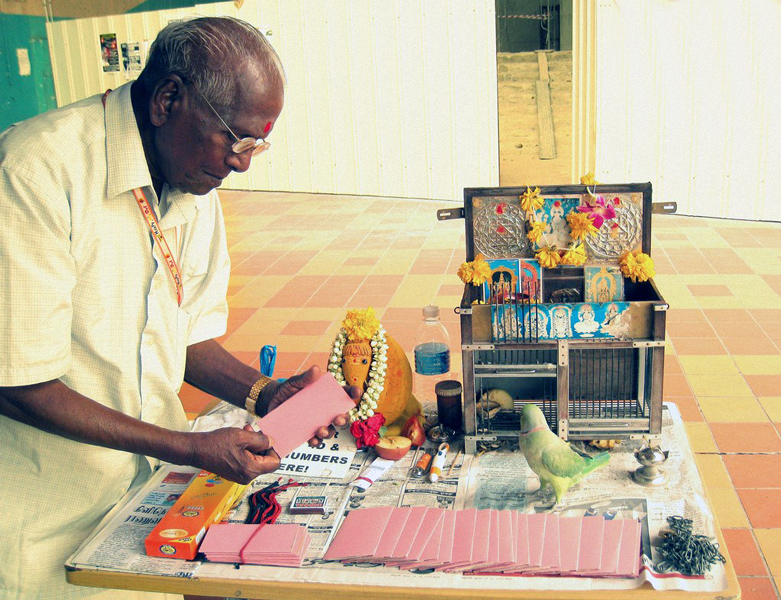Amma Meenakshi, pick a card for Ramya after worshipping Kamakshi,” says Selvam. Meenakshi, the parrot, squeaks and hops out of the cage, climbs up a box seemingly to worship Goddess Kamakshi, who is placed on top of the box, alights and pecks at a stack of tarot cards. Then it pulls out one and hands it over to Selvam who prays to the goddess and starts reading the predictions for Ramya, after rewarding the parrot a grain for its services.

The above scene is what is called ‘parrot astrology’ (kili josiyam in Tamil), a common sight in Tamil Nadu, especially in the smaller towns where one can see the parrot astrologer seated underneath a tree or by the roadside, with a deck of cards and a cage. The fee for his services is a nominal ₹11 or ₹21.
Mythological connect
But why parrot? Why not a crow or a dove? The Upanishads say that parrots can foresee the future. A mythological story relates that when Saint Purandharadhasar failed to recognise Ram, Lakshman and Sita in disguise, a parrot perched on a tree branch screeched “Ram, Ram!” And the sage who had been meditating for long for Ram’s darshan fell at his feet. Hindu mythology is rich with more such legends, including that of Saint Arunagirinathar composing the poems on Lord Karthikeya, in a parrot’s body; in fact, the Taitriya Upanishad is dedicated to the bird.
It is believed that parrots can even predict extreme weather conditions such as storms or cyclones. It is a well-known fact that hours before the tsunami hit Chennai and the coastal towns, birds showed strange behaviour.
Parrots hold significance with the Hindu deities too. Saint Andal is depicted with a parrot in her left hand. This parrot is specially made of leaves daily and given to a devotee at the end of the day. It is believed this brings luck. A family is dedicated to making these parrots. A parrot adorns the right shoulder of Goddess Meenakshi and is believed to impart knowledge of 64 art forms to her. The Kili Mandapam in the Madurai Meenakshi temple has several parrots housed in it. When you call out ‘Rama’ or ‘Meenakshi’, the birds repeat after you. They are believed to have repeated the Vedas which strengthens the theory that all good thoughts we utter are repeated.
We eat meat and chicken. But what is the logic behind banning parrot astrology which has been providing a livelihood for people for years?
Parrot is the mount of Kama, the god of love. Parrots also served as messengers as mentioned in certain verses of various Tamil literature. Andal’s parrot holds pride of place in recognition for serving as a messenger of love between her and Lord Vishnu, say the puranas.
A waning profession
Unfortunately, times are bad for parrot astrology, thanks to animal welfare activists and organisations such as PETA. Selvam cannot understand why, because in kili josiyam, the bird is not harmed or tortured. On the contrary it is looked after well and fed too.
To add to this, the present generation is not interested in pursuing the vocation, laments Selvam. The art is generally passed on from generations. Selvam’s forefathers were parrot astrologers. “I used to accompany my father as a child and when I grew up, he trained Meenakshi and gifted her to me.” Meenakshi has been with Selvam for the past seven years. A parrot’s lifespan is 40 years and female parrots are generally used for kili josiyam, he says.
“We never lie nor do we exaggerate. We only read out whatever card our parrot picks out,” he adds. There are 27 tarot cards symbolising as many stars in the cosmic system and each card contains a picture of a Hindu god or Jesus Christ, Mary or the Quran too.
On an average, an astrologer earns around ₹200 a day and “on festive seasons, I take home at least ₹1,000,” says Selvam.
Woes
Chitra Ganapathy who runs the Kadambavanam resort in Madurai relates how a parrot astrologer who was engaged by the resort was robbed of his livelihood by forest officials; they snatched away his cage, along with the parrots, reasoning that it was illegal to cage the birds. They agreed to give it back to him for a bribe of ₹5,000. “That is huge money for these people,” says Chitra.
She asks: “We eat meat and chicken. But what is the logic behind banning parrot astrology which has been providing a livelihood for people for years?” Food for thought?






